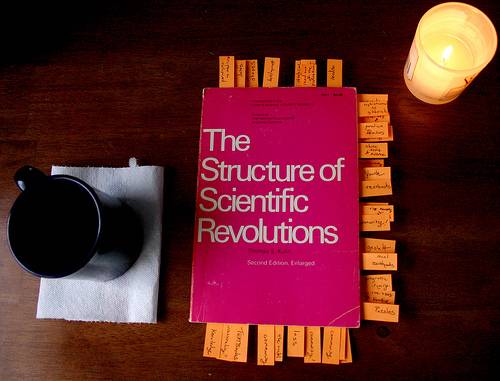K U H N F E S T
“One is not one’s own historian, let alone one’s own psychoanalyst.”—Thomas Kuhn, via a 1991 profile in Scientific American
In 1962, Thomas Kuhn published The Structure of Scientific Revolutions, making good on an earlier monograph that ran in the International Encyclopedia of Unified Science. 50 years later, “paradigm shift” is a ubiquitous reference for pomo and post-structuralist thinkers tinkering at the edges of science and culture, and we get our staid facts straight in deciphering one “Bad Newton” from another. For Kuhn, the drama of the paradigm shift really begins to unfold in times of crisis, when revolutionary science unveils challenging alternatives to then-dominant models, introducing a period of uncertain allegiances until the new paradigm is able to assert itself.
The initial publication climate for Kuhn’s signature work was tenuous—the nation was soon-to-be knee-deep in the Cuban Missile Crisis, and had already weathered Federal Marshalls escorting James Meredith to classes at the University of Mississippi. Other soon-to-be cultural memes blotted the radar:
- the debut of The Incredible Hulk #1
- Students for a Democratic Society’s draft of the “Port Huron Statement”
- John Lennon’s under-the-radar marriage to Cynthia Powell
- Johnny Carson’s semi-permanent takeover ofThe Tonight Show
- The Wizard of Oz’s last December telecast until the mid-1990s
- The birth of Motel 6
In the next half-century, the book would go through four editions, including Kuhn’s initial postscript to detractors in the Second Edition (1969), where he defended against charges of relativism and the distinctions between normative and descriptive analysis.
By the time of the book’s Third Edition, published in 1996 (Kuhn had passed away earlier that year), the book was reportedly the most cited of any in the fields of art and the humanities, by the creators of the Arts & Humanities Citation Index, and “paradigm shift” was fodder as an emptied-out buzzword high-brow comics and other satirical media.
Now in a 50th Anniversary Edition printing, with an Introduction to all things Kuhnian by Ian Hacking, The Structure of Scientific Revolutions still generates its fair share of admiration—and controversy.
As Hacking writes:
ONE THING IS NOT SAID often enough: Thomas S. Kuhn’s The Structure of Scientific Revolutions, like all great books, is a work of passion, and a passionate desire to get things right. This is plain even from its modest first sentence: “History, if viewed as a repository for more than anecdote or chronology, could produce a decisive transformation in the image of science by which we are now possessed.” Thomas Kuhn was out to change our understanding of the sciences—that is, of the activities that have enabled our species, for better or worse, to dominate the planet. He succeeded.
In celebration of the book’s anniversary publication, symposia and conferences are starting to creep up on the blotter. Among them? Kuhnfest, at the Minnesota Center for the Philosophy of Science, which unfolds a series of interest group-affiliated readings and keynote lectures over the course of the next three months.
What would Kuhn—once a young physics student with Midwestern roots—have to say about all the fuss? “As in political revolutions, so in paradigm choice—there is no standard higher than the assent of the relevant community.” Seems apt.


